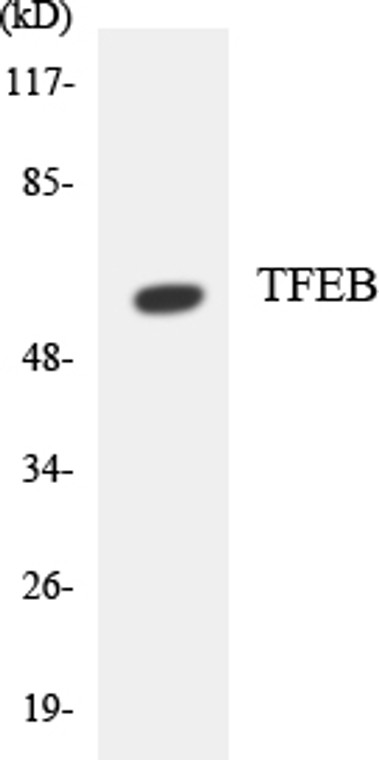| Host: |
Rabbit |
| Applications: |
WB/IHC/IF/ELISA |
| Reactivity: |
Human/Mouse |
| Note: |
STRICTLY FOR FURTHER SCIENTIFIC RESEARCH USE ONLY (RUO). MUST NOT TO BE USED IN DIAGNOSTIC OR THERAPEUTIC APPLICATIONS. |
| Short Description: |
Rabbit polyclonal antibody anti-Transcription factor EB (10-59 aa) is suitable for use in Western Blot, Immunohistochemistry, Immunofluorescence and ELISA research applications. |
| Clonality: |
Polyclonal |
| Conjugation: |
Unconjugated |
| Isotype: |
IgG |
| Formulation: |
Liquid in PBS containing 50% Glycerol, 0.5% BSA and 0.02% Sodium Azide. |
| Purification: |
The antibody was affinity-purified from rabbit antiserum by affinity-chromatography using epitope-specific immunogen. |
| Concentration: |
1 mg/mL |
| Dilution Range: |
WB 1:500-1:2000IHC 1:100-1:300ELISA 1:20000IF 1:50-200 |
| Storage Instruction: |
Store at-20°C for up to 1 year from the date of receipt, and avoid repeat freeze-thaw cycles. |
| Gene Symbol: |
TFEB |
| Gene ID: |
7942 |
| Uniprot ID: |
TFEB_HUMAN |
| Immunogen Region: |
10-59 aa |
| Specificity: |
TFEB Polyclonal Antibody detects endogenous levels of TFEB protein. |
| Immunogen: |
The antiserum was produced against synthesized peptide derived from the human TFEB at the amino acid range 10-59 |
| Function | Transcription factor that acts as a master regulator of lysosomal biogenesis, autophagy, lysosomal exocytosis, lipid catabolism, energy metabolism and immune response. Specifically recognizes and binds E-box sequences (5'-CANNTG-3').efficient DNA-binding requires dimerization with itself or with another MiT/TFE family member such as TFE3 or MITF. Involved in the cellular response to amino acid availability by acting downstream of MTOR: in the presence of nutrients, TFEB phosphorylation by MTOR promotes its cytosolic retention and subsequent inactivation. Upon starvation or lysosomal stress, inhibition of MTOR induces TFEB dephosphorylation, resulting in nuclear localization and transcription factor activity. Specifically recognizes and binds the CLEAR-box sequence (5'-GTCACGTGAC-3') present in the regulatory region of many lysosomal genes, leading to activate their expression, thereby playing a central role in expression of lysosomal genes. Regulates lysosomal positioning in response to nutrient deprivation by promoting the expression of PIP4P1. Acts as a positive regulator of autophagy by promoting expression of genes involved in autophagy. In association with TFE3, activates the expression of CD40L in T-cells, thereby playing a role in T-cell-dependent antibody responses in activated CD4(+) T-cells and thymus-dependent humoral immunity. Specifically recognizes the gamma-E3 box, a subset of E-boxes, present in the heavy-chain immunoglobulin enhancer. Plays a role in the signal transduction processes required for normal vascularization of the placenta. Involved in the immune response to infection by the bacteria S.aureus, S.typhimurium or S.enterica: infection promotes itaconate production, leading to alkylation, resulting in nuclear localization and transcription factor activity. Itaconate-mediated alkylation activates TFEB-dependent lysosomal biogenesis, facilitating the bacteria clearance during the antibacterial innate immune response. |
| Protein Name | Transcription Factor EbClass E Basic Helix-Loop-Helix Protein 35Bhlhe35 |
| Cellular Localisation | NucleusCytoplasmCytosolLysosome MembraneMainly Present In The CytoplasmWhen Nutrients Are PresentRecruited To The Lysosomal Membrane Via Association With Gdp-Bound Ragc/Rragc (Or Ragd/Rragd): It Is Then Phosphorylated By MtorPhosphorylation By Mtor Prevents Nuclear Translocation And Activity By Promoting Interaction With 14-3-3 ProteinsSuch As YwhazUnder Aberrant Lysosomal Storage ConditionsIt Translocates From The Cytoplasm To The NucleusThe Translocation To The Nucleus Is Regulated By Atp13a2ConverselyInhibition Of Mtorc1Starvation And Lysosomal DisruptionPromotes Dephosphorylation And Translocation To The NucleusExported From The Nucleus In Response To Nutrient AvailabilityIn MacrophagesTranslocates Into The Nucleus Upon Live SEnterica Infection(Microbial Infection) Following Coxsackievirus B3 InfectionFull Length Tfeb And Viral Protease 3c-Mediated Cleavage Product Are Translocated From The Cytoplasm To The Nucleus |
| Alternative Antibody Names | Anti-Transcription Factor Eb antibodyAnti-Class E Basic Helix-Loop-Helix Protein 35 antibodyAnti-Bhlhe35 antibodyAnti-TFEB antibodyAnti-BHLHE35 antibody |
Information sourced from Uniprot.org
12 months for antibodies. 6 months for ELISA Kits. Please see website T&Cs for further guidance











